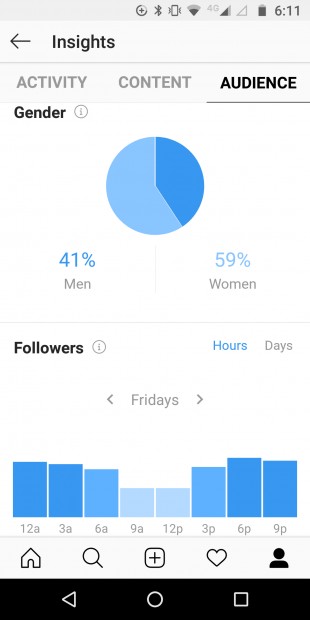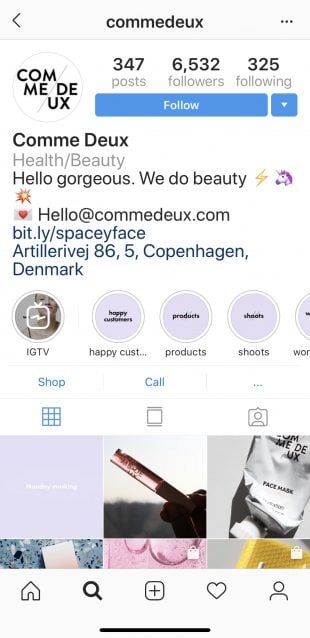More than 25 million firms worldwide are already utilizing Instagram for business, and more than 200 million users visit at least one business profile day by day.
As Facebook refocuses on connecting people with content from friends family, Instagram has become “the new home for brands,” where engagement is high, followers are brand-loyal, and real enterprise objectives could be achieved.
Here’s everything you know about how you can use Instagram for business—whether you are just getting began or you simply need to refine your existing strategy.
Step 1: Get an Instagram business account
When you already have a personal Instagram account with brand-appropriate content and an established following, you may want to simply convert it to an Instagram business account. This provides you access to all of the business functions, however, makes the transition seamless for your existing followers.
You can also select to make a brand-new Instagram business account. That is the right selection when you don’t have an existing personal account, or in case your personal account doesn’t accurately represent your business.
How to set up an Instagram business account from scratch
- Download the Instagram app for Android, iOS or Windows.
- Open the app and tap Sign Up.
- Enter your email handle and tap Next. If you want to connect your Instagram business account to your Facebook Business Page, be sure to use an admin email address to sign up, or tap Log in with Facebook.
- Select your username and password and fill in your profile info. (We will dive into how to optimize your Instagram business profile info later in this post.)
- Tap Done.
- You now have a personal Instagram account that’s ready to convert to a business account. Continue by following the steps below.
How to convert a personal Instagram account to a business account
- Log into your existing personal Instagram account on the app.
- Tap the profile icon to go to your profile.
- Tap the three lines icon at the upper right of the screen, then choose Settings.
- Tap Switch to Business Profile, then Continue.
- (Optional) If you want to connect your Instagram business account to your Facebook business page, follow the prompts to do so.
- Add contact info: Your Instagram for business account should include an email address, a phone number, or a physical address (or all of these).
- Tap Done.
Step 2: Create a winning Instagram strategy
Define your target audience
Before you could decide what sort of content to publish on Instagram, you should think about who’s going to see it.
The vast majority of Instagram users are under the age of 35, with a fairly close split between female and male users. The USA has the biggest number of Instagram users, closely followed by Indonesia, India, and Brazil. That is good info to get you began, however, you should go beyond these overall Instagram demographics to define a target audience unique to your brand.
Since defining your target market is one of the most essential parts of your marketing technique for any marketing tool. Right here’s the brief version:
- Determine who already buys from you.
- Check the analytics on your other social media platforms to learn who follows you there.
- Do some thorough competitor research.
- Create a clear worth statement for your brand.
When you know who your audience is, think about what sort of content they want to see from you. What sort of content do they publish on their own accounts? How do they interact with your opponents or similar brands?
Set goals and objectives
Understanding what you want to accomplish by utilizing Instagram for business is the first stage in making a great Instagram strategy. Understanding your targets keeps you on track and permits you to focus all your efforts on achieving real business goals.
Effective goals follow the SMART framework. Which means they’re:
- Specific
- Measurable
- Attainable
- Relevant, and
- Timely
As you build your Instagram presence, it’s okay to have targets based on vanity metrics like likes, follows, and comments. However, ensure you also set targets that relate to real business goals. Which leads us to…
Concentrate on the right performance metrics
The exact metrics to measure and track will vary for each enterprise. However, broadly, you must concentrate on metrics related to the social funnel.
Which means your targets should align to one of the 4 stages in the customer journey:
- Awareness: Contains metrics like brand awareness, follower development rate, and post reach.
- Engagement: Contains metrics like engagement fee (based on likes) and amplification fee (based on shares).
- Conversion: In addition to conversion fee, this contains metrics like click-through fee and bounce fee. When you’re utilizing paid adverts, conversion metrics also include cost per click and CPM.
- Customer: Those metrics are based on actions customers take, like providing testimonials.
Commit to a regular posting schedule
When you begin building a following on Instagram, your followers will expect to see posts from you regularly. You want to keep them aware of your brand and engage with your content without overwhelming them to the point that they tune out—or worse, unfollow.
There’s nobody time that’s best to publish for all companies. Hootsuite and Unmetric analyzed 200,000 Instagram posts in 11 different industries and decided that the best time to post on Instagram varies greatly relying on your industry. The Food and Beverage industry, for instance, finds the most success posting at 12 p.m., while the Education industry receives lost of engagement when they publish at 4 p.m.
Besides benchmarking your account against other top brands in your industry, you should do some testing to determine what times seem to make the most engagement for your posts (more on that later).
The important thing is to know when your viewers are online. Keep in mind that they might not be in the same time zone as you’re. Instagram Insights shows you exactly when your followers are online, broken down by day.
To access this data, go to your Instagram business profile, click on the three bars icon in the upper right, then click on Insights. Click on the Audience tab and scroll down to see active times.
Once you determine your greatest time to publish, create a content calendar to plan and schedule your Instagram content in advance.
Step 3: Optimize your profile
You entered some basic profile data if you first created your Instagram business account. Now it’s time to optimize your profile for the best outcomes. Right here’s a brief video that goes over the highlights:
Tweak your bio
Your Instagram bio is only 150 characters long, however, it should do lots of heavy lifting. It tells first-time visitors who you’re, what your brand is all about, and why they need to care.
How do you cram so much info into such a small space, while also conveying brand personality? We have got a full guide to making an effective Instagram bio for business, however, here are some quick tips:
- Use your brand voice: Convey your personality. Go casual, or professional, or a little bit cheeky, relying on what makes the sense for your business.
- Include hashtags: Instagram bio hashtags are clickable and are an effective way to show off user-generated content.
- Try emoji: These little symbols could help you convey lots of info in just one character.
- Use spacing and line breaks: Line breaks create your bio simpler to read online.
Optimize your profile pic
For most companies, the best profile pic is a few version of your logo. Use the same image you utilize on other social profiles to help people immediately identify your brand.
Your profile picture displays as 110 x 110 pixels, however, it’s stored at 320 x 320 pixels. Which means it’s a good suggestion to add a photo at least 320 pixels square to make sure you’re ready if Instagram changes how profile images are displayed.
Your profile pic is cropped into a photo on the app, so be sure your logo is totally visible in this shape.
Ensure your profile is complete
Use all of the parts of your Instagram business account to their full advantage.
- Name and username: Those are the only parts of your Instagram profile which are included in Instagram search, so use them wisely. Include your real brand name as well as any variations (like a common abbreviation). Utilizing the same username (or handle) on all social networks makes it simpler for followers to find you.
- Website: That is the only spot on Instagram where you could post an organic clickable link, so make sure to include one! Link to your website, your newest blog post, a current campaign, or a special Instagram landing page.
Take advantage of Instagram business profile features
If you use Instagram for business, you gain access to several profile functions not available to personal accounts. Whether you are changing a personal account or starting from scratch, ensure you take advantage of these business-only options:
- Contact info: Embody your email address, phone number, or physical address so followers could connect with you directly from your profile. If you add contact info, Instagram creates corresponding buttons (Call, Email, or Get Directions) for your profile.
- Category: This appears below your name and shows people at a glance what you do.
- Call-to-action buttons: These permit customers to book an appointment, make reservations, purchase tickets, and more, right from your Instagram profile. From your business profile, tap Edit Profile, then Contact Options, then Add an action button.
Comme Deux uses all the available business profile options for the Instagram business account. Their physical address is shown, the category is indicated as Health/Beauty, and they have a Shop call-to-action button.



